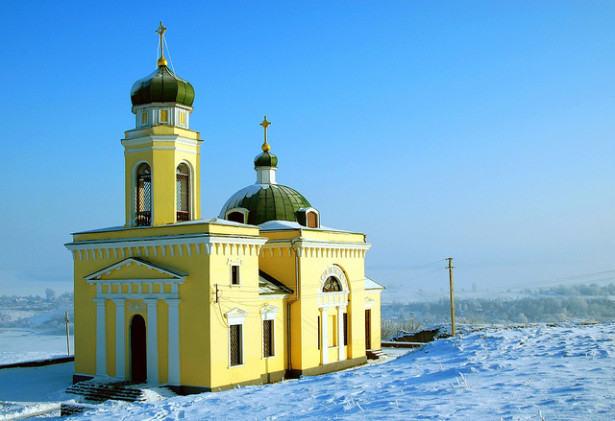
News of the protests in Ukraine has spread across the world, especially because the street conflicts have escalated to the point of violence. Some protesters are fighting with makeshift weapons and throwing fire bombs, while the police have responded with lethal violence that has left at least four protesters dead. The administration is in turmoil: In late January, Prime Minister Mykola Azarov and his cabinet resigned, while President Viktor Yanukovych declared sick leave. Former President Leonid Kravchuk is now warning that the country is now on the brink of civil war.
While mainstream media has extensively covered the street violence, political turmoil and the rising presence of fascist parties, these outlets have largely ignored — or misunderstood — the significant role being played by religious institutions in Ukraine.
Most commentary on the role of clergy has been superficial, largely due to ignorance of the complicated politics of the Orthodox Church. There are actually three different Orthodox Churches in Ukraine: the Ukrainian Orthodox Church-Kiev Patriarchate, the Ukrainian Autocephalous Orthodox Church and the Ukrainian Orthodox Church-Moscow Patriarchate. The former two churches split from the Moscow Patriarchate over the clash between Ukrainian nationalism and Russian imperialism, and the Moscow branch is largely seen as a conservative backer for Russia. Given that the conflict in Kiev was sparked by Yanukovych’s turn away from the European Union towards Russia, the churches and their relationship to the protests could be expected to continue to split along these geopolitical lines.
However, all three churches have been working to deescalate the violence in Ukraine. Many protesters are seeking refuge at St. Michael’s Ukrainian Orthodox Cathedral. Roman Tsado, 25, told Reuters, “They [the clergy] gave us tea to warm us up, told us to keep our spirits strong and told us not to fight evil with evil.” Priests have also been praying in the deadly “grey zones” between the riot police lines and the protesters in defiance of the government’s recent ban on prayer services at protests. The AFP reports that there are at least two tents on the square, which are “used as places of worship, where protesters pray, go for confession and even have their children christened.”
Even members of the Moscow Patriarchate have become involved. In a widely circulated photograph, two monks wearing clerical garb are standing and praying for peace in front of a large line of riot police. The power of this photo, which was largely lost on international media, is that these priests are actually from Kiev Caves Monastery, which is under the jurisdiction of the Ukrainian Orthodox Church-Moscow Patriarchate.
The fact that monks from the Moscow Patriarchate — who are typically more conservative than ordinary clergy — have taken steps to reduce violence is significant. The Moscow Patriarchate is seen by many to be the ally of Putin. Yet, the violence in Ukraine has reached such a level that even the so-called “spiritual backers” of the government are calling for it to end. In a joint-Orthodox statement condemning the violence, representatives from both the Moscow Patriarchate and the Independent Ukrainian church calls on clergy to resist the violence and for Ukraine politicians “to find a peaceful way out of the social crisis.”

Mothers of Maidan promote peace
Feb. 12, 2014, 6:58 p.m. | Ukraine — by Daryna Shevchenko
http://www.kyivpost.com/content/ukraine/mothers-of-maidan-promote-peace-336730.html
The movement was started in response to violent clashes on Jan. 19-22, during which at least four demonstrators were killed in police attacks. The victims’ photographs are on display here, with the inscription: “I will carry on your pain.”
Mothers of Maidan conducted their first anti-violence protest on Jan. 24. Wearing posters that said “Mama,” they lined in the no-man’s territory between the Berkut riot-control police and the protesters, holding hands, praying and begging the police to come over to the other side.
Thanks. Eye-opening indeed.
Here’s another article on the protests – from the standpoint of two Orthodox participants: http://www.pravoslavie.ru/english/68195.htm
Thank you Mr. Donaghy. I came across this article several days ago. Also consider the website Pravmir, which is an official Russian Orthodox publication. It’s amazing that they published the “Statement of Clergy and Faithful on the Situation in Ukraine” in both English and Ukrainian.
On another note the top hierarch Russian Orthodox Church Outside of Russia (ROCOR) has also denounced the violence. This is interesting because there are two main Russian Orthodox jurisdictions in the US. The Orthodox Church in America (OCA) and ROCOR. Both are in full communion with each other but they don’t play along well. ROCOR tends to be more conservative and has more ethnic Russian ties. http://www.pravmir.com/metropolitan-hilarion-eastern-america-new-york-makes-appeal-prayers-peace-ukraine/
This article is anti-Russian. Looks like the Serbian Church is pro-Uniate. It’s no surprise since the Serbian Church is riddled with ecumenism. Why not, in the spirit of unity with the Vatican, change St. Steven’s to St. Stepinac’s Serbian Church?